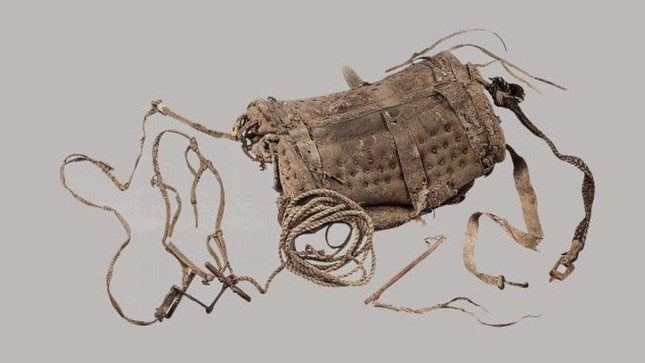According to a recent study, archaeologists have unearthed an exquisitely crafted leather saddle—potentially the oldest ever discovered—from a tomb in northwestern China.
The saddle, preserved for 2,700 years in a dry desert, was found in the tomb of a woman at a cemetery in Yanghai, located in the Turpan Basin of the Xinjiang Uyghur Autonomous Region of China. The woman was clad in a leather coat, woolen trousers, and short leather boots, and had a “leather saddle placed on her hips as if she were sitting on it”, according to the study published in the journal Archaeology in Asia.
The saddle—comprising two leather cushions filled with a mix of straw, deer hair, and camel fur—dates between 724 and 396 BCE, based on radiocarbon dating methods. It may predate known saddles from the Scythians—nomadic, warlike horse riders from the Eurasian steppes who interacted with ancient Greeks and Romans.
The earliest known Scythian saddles appear to date from the 5th to 3rd centuries BCE and have been found in the Altai Mountains of Siberian Russia and in eastern Kazakhstan.

The exquisite leather saddle dating back to around 700 BCE, possibly the earliest found.
Patrick Wertmann, the lead author of the study and an archaeologist at the University of Zurich, Switzerland, stated that the tombs in Yanghai are believed to belong to individuals of the Subeixi culture, who inhabited the Turpan Basin approximately 3,000 years ago. This culture is named after a burial site featuring other tombs near the modern town of Subeixi, located about 50 kilometers northeast of Yanghai.
Saddle Development
Archaeologists currently believe that horses were domesticated as livestock around 6,000 years ago. However, the earliest evidence indicates they were raised for milk and meat.
The first riders used a saddle on the horse’s back secured with straps; carvings show Assyrian cavalry equipped with such saddles as early as the 7th century BCE.
Wertmann remarked, “Archaeologists do not know exactly when saddles were invented, but they may have been developed by horse riders in Central Asia around the mid-first millennium BCE. This would make the saddle from Yanghai one of the oldest known.
The evolution of the saddle began when riders became more concerned with comfort and safety, as well as the health of their horses. Saddles allow people to ride longer distances, thus leading to more interactions among different peoples.
The early Scythian saddles and the Yanghai saddle both featured separate supports, helping riders maintain a stable position and elevate themselves above the saddle, for example, while shooting arrows. Wertmann noted that the earliest saddles lacked stirrups.
Female Rider
The study’s authors wrote that the Subeixi people had weapons, horse gear, and clothing similar to the Scythians and may have interacted with them in the Altai Mountains.
However, while the Scythians were nomadic, the Subeixi horse riders may have been pastoralists caring for livestock in the Turpan Basin.
Shevan Wilkin, a molecular archaeologist at the University of Zurich, Switzerland, who was not involved in the study, suggested that the extraordinary preservation of the Yanghai saddle indicates that other possibly older saddles could be found nearby.
The seated position of the woman buried with the saddle indicates she was a rider. “This really changes our ideas about who the riders were,” Wilkin stated.
Birgit Bühler, an archaeologist at the University of Vienna who also did not participate in the study, noted that the discovery in an ordinary tomb is strong evidence that this woman engaged in the daily activities of pastoralists, including herding livestock and traveling.
This finding contradicts traditional historical narratives that assert that only men rode horses and participated in warfare.





















































